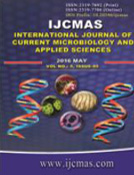


 National Academy of Agricultural Sciences (NAAS)
National Academy of Agricultural Sciences (NAAS)

|
PRINT ISSN : 2319-7692
Online ISSN : 2319-7706 Issues : 12 per year Publisher : Excellent Publishers Email : editorijcmas@gmail.com / submit@ijcmas.com Editor-in-chief: Dr.M.Prakash Index Copernicus ICV 2018: 95.39 NAAS RATING 2020: 5.38 |
The study was conducted by treatment of termite diet media with CSI (Lufenuron). The concentrations 8000, 10000 and 12000 ppm were used to know the mortalities in workers and soldiers of termite Microcerotermes diversus (Silv.) at different temperature degrees (20, 25, 30, 35 + 3°C). Lufenuron at all concentrations and temperature degrees caused a gradual mortality and the results also showed no difference in susceptibility between workers and soldiers towards toxicity of Lufenuron. Temperate had a significant effect on the speed up of incidence of mortality. Therefore, the mortality percentage reached to 100% in workers and soldiers after 28 days from treatment at temperature of 25 and 30 + 3 oC, and after 49 days at temperature of 20 and 35 + 3°C . The second reinfestation of the same treated diet after 60 days and the third reinfestation after 90 days of treatment had shown a gradual relative decline in the percentage mortalities of termite individuals depending on the duration of exposure. Mortality percentages reached to more than 50% at the highest concentration (12000 ppm) and less than 50% at the lowest concentration (8000 ppm) at temperatures at 25 and 30 + 3 oC after 90 days from treatment. The results showed that there is a positive correlation between concentrations and mortality percentages at all temperature degrees. It could be conducted that the effective duration and persistence of Lufenuron depend on concentration, temperature and exposure time.
 |
 |
 |
 |
 |